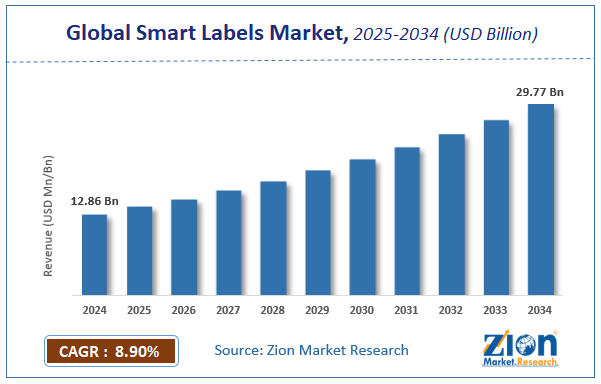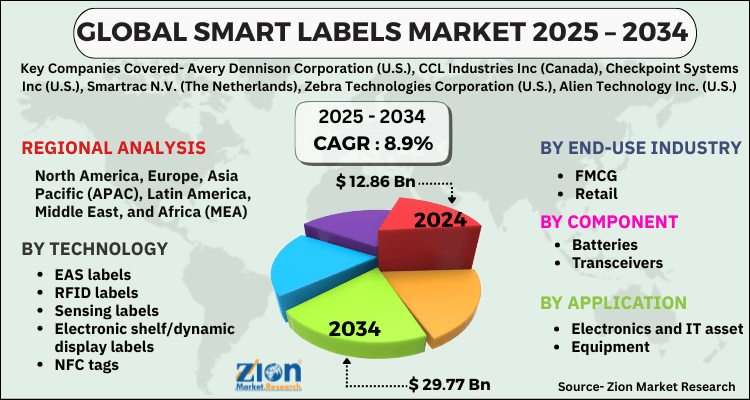Global Smart Labels Market Size, Share, Growth Analysis Report - Forecast 2034

Smart Labels Market By Technology (EAS labels, RFID labels, Sensing labels, Electronic shelf/dynamic display labels,NFC tags), By End-Use Industry (FMCG, Retail, Automotive, Logistics, Manufacturing, Healthcare, Others), Component (Batteries, Transceivers, Microprocessors, Memories, Others), Application (Electronics and IT asset, Equipment, Retail & Inventory tracking, Pallet, Perishable goods, Others), and By Region: Global and Regional Industry Overview, Market Intelligence, Comprehensive Analysis, Historical Data, and Forecasts 2025 - 2034
| Market Size in 2024 | Market Forecast in 2034 | CAGR (in %) | Base Year |
|---|---|---|---|
| USD 12.86 Billion | USD 29.77 Billion | 8.9% | 2024 |
Smart Labels Market: Industry Perspective
The global smart label market size was worth around USD 12.86 billion in 2024 and is predicted to grow to around USD 29.77 billion by 2034, with a compound annual growth rate (CAGR) of roughly 8.9% between 2025 and 2034. The report analyzes the global smart labels market's drivers, restraints/challenges, and the effect they have on the demands during the projection period. In addition, the report explores emerging opportunities in the smart labels industry.
Smart Labels Market: Overview
A smart label is a slip for an item identification which contains more advanced technologies than bar code data which leads to advantageous features such as quick identification, automated reading, high tolerance, reduced errors, and re-programmability. These labels are approximately 0.3 millimeters thick made from paper, plastics, or fabrics and are used as printed labels, chip labels, or electronic labels. They are usually designed to record, receive, and transmit the digital information which leads to the reduction of total time tracking. Moreover, rising industrial use of these labels leads to minimized human errors, owing to its efficiency and accuracy.
Increased demand for the security and tracking solutions is the major factor driving the smart labels market growth. Moreover, the growing retail sector is also the strong factor driving the growth of the smart labels market. Growing retail sector leads to the rising demand for the smart labels in merchandise and asset tracking. In addition to this, increase in the adoption of smart labels in packaging industry results in the ability to offer detailed data to the customers about the products with the use of smart devices. The features offered by the smart labels such as real-time location tracking, re-programmability, and high tolerance, among others are anticipated to boost the market across the globe in various sectors in the upcoming years. However, additional cost incurred by the use of smart labels is projected to hamper the market growth in the forecast timeframe.
Smart technology has substantially increased in popularity and scope of application all over the globe and this trend is anticipated to propel the smart labels market growth over the forecast period. Smart labels enable better tracking and better identification opportunities that save time and reduce errors. They have been seeing a substantial rise in popularity in smart packaging and smart logistics operations.
Rising technological proliferation and increasing digitization are expected to boost demand for smart labels over the forecast period. These smart labels provide more surveillance of products and provide better information, as they are practically embedded electronic devices with advanced capabilities.
However, the mechanical susceptibility and functioning capability of these smart labels are expected to act as restraining factors for the global smart labels market growth over the forecast period.
COVID-19 Impact:
The COVID-19 pandemic resulted in a huge drop in smart label sales and created a major adverse situation for smart labels market growth. Lockdown restrictions created a downfall situation in the global smart labels marketplace in 2020 and resulted in losses for smart labels manufacturers.
Smart labels saw a drop in demand as multiple sales and distribution channels were shuttered under the lockdown restrictions. Disrupted logistics and inadequate manufacturing landscape led to a demand-supply gap in the global smart labels market landscape and resulted in a negative growth trend for the smart labels market potential through 2028.
In the post-pandemic era, the smart labels market is expected to make a comeback at a steady pace and is expected to see good growth through the forecast period.
Smart Labels Market: Growth Drivers
Increasing Advancements in Technology to Boost Smart labels Market Growth
Advancements in technology have substantially risen over the past few years and this trend is anticipated to be prominent over the forecast period as well. Increasing use and integration of technologies like Big Data, IoT, artificial intelligence, and virtual reality are also expected to further bolster the smart labels market potential in the long run.
Smart Labels Market: Restraints
Mechanical susceptibility and Functioning capabilities
Smart Labels usually use different components made of various elements that act differently in different environments and this affects their overall functionality and capability. The high cost of production associated with these smart labels is also anticipated act as a restraining factor for the smart labels market growth over the forecast period.
Global Smart Labels Market: Segmentation
The global Smart Labels market is segregated based on technology, component, end-use industry, application, and region.
By technology, the market is divided into EAS labels, RFID labels, Sensing Labels, Electronic shelf/dynamic display labels, and NFC tags. The RFID labels have seen a substantial increase in popularity in the past few years and are anticipated to maintain this stance over the forecast period as well. Their simple nature of use and easy accessibility are anticipated to be major factors driving the smart labels market growth through 2028.
By end-use industry, the Smart Labels market is segmented into FMCG, Retail, Automotive, Logistics, Manufacturing, Healthcare, and Others (aerospace, library, construction, and postal services). The retail sector is projected to have a bright outlook over the forecast period in the global smart labels market landscape through 2034.
By Component, the global smart labels market is split into Batteries, Transceivers, Microprocessors, Memories, Others.
In terms of Application, the global smart labels market is categorized into Electronics and IT asset, Equipment, Retail & Inventory tracking, Pallet, Perishable goods, Others.
Smart Labels Market: Report Scope
| Report Attributes | Report Details |
|---|---|
| Report Name | Smart Labels Market |
| Market Size in 2024 | USD 12.86 Billion |
| Market Forecast in 2034 | USD 29.77 Billion |
| Growth Rate | CAGR of 8.9% |
| Number of Pages | 188 |
| Key Companies Covered | Avery Dennison Corporation (U.S.), CCL Industries Inc (Canada), Checkpoint Systems Inc (U.S.), Smartrac N.V. (The Netherlands), Zebra Technologies Corporation (U.S.), Alien Technology Inc. (U.S.), Sato Holding Corporation (Japan), and Intermec Inc. (U.S.), and others. |
| Segments Covered | By Technology, By End-Use Industry, By Component, By Application, and By Region |
| Regions Covered | North America, Europe, Asia Pacific (APAC), Latin America, The Middle East and Africa (MEA) |
| Base Year | 2024 |
| Historical Year | 2020 to 2023 |
| Forecast Year | 2025 - 2034 |
| Customization Scope | Avail customized purchase options to meet your exact research needs. Request For Customization |
Smart Labels Market: Regional Landscape
Asia Pacific region will see the fastest growth of all regions in the global smart labels market landscape. The increasing popularity of technology and rising adoption of smart technologies are expected to boost demand in this region. Emerging economies of China, India, and Japan are projected to be the most important markets in this region over the forecast period.
The market for Smart Labels in North America is expected to hold a dominant revenue share in the global smart labels marketplace and this can be attributed to increasing technological proliferation and rising adoption of novel technologies in this region. The increasing popularity of smart devices and rising trends of smart packaging and smart logistics are further boosting the smart labels market potential over the forecast period. The United States is anticipated to be the major market for smart labels in this region through 2028.
Recent Developments
- In August 2019, Smartrac, a leading manufacturer of RFID inlays and announced the launch of Skyline tags that will be used in industrial applications these new chips are equipped with RAIN RFID chips with the connectivity of up to 6 meters.
Smart Labels Market: Competitive Landscape
Some of the main competitors dominating the global Smart Labels market include:
- Avery Dennison Corporation (U.S.)
- CCL Industries Inc. (Canada)
- Checkpoint Systems Inc. (U.S.)
- Smartrac N.V. (The Netherlands)
- Zebra Technologies Corporation (U.S.)
- Alien Technology Inc. (U.S.)
- Sato Holding Corporation (Japan)
- Intermec Inc. (U.S.)
The global smart labels market is segmented as follows;
By Technology
- EAS labels
- RFID labels
- Sensing labels
- Electronic shelf/dynamic display labels
- NFC tags
By End-Use Industry
- FMCG
- Retail
- Automotive
- Logistics
- Manufacturing
- Healthcare
- Others (aerospace, library, construction, and postal services)
By Component
- Batteries
- Transceivers
- Microprocessors
- Memories
- Others (antenna and another basic component)
By Application
- Electronics and IT asset
- Equipment
- Retail & Inventory tracking
- Pallet
- Perishable goods
- Others (reusable goods, security access, patient care smart wrist bands, and general assets)
By Region
- North America
- The U.S.
- Canada
- Europe
- France
- The UK
- Spain
- Germany
- Italy
- Rest of Europe
- Asia Pacific
- China
- Japan
- India
- South Korea
- Southeast Asia
- Rest of Asia Pacific
- Latin America
- Brazil
- Mexico
- Rest of Latin America
- Middle East & Africa
- GCC
- South Africa
- Rest of the Middle East & Africa
Table Of Content
Methodology
FrequentlyAsked Questions
Smart labels are advanced labels embedded with technologies like QR codes, RFID, or NFC that can store and transmit information. They are used to track products, provide real-time data, enhance inventory management, and offer interactive experiences for consumers.
The global smart labels market is expected to grow due to increasing adoption in retail, logistics, and healthcare for real-time tracking and authentication of products.
According to a study, the global smart labels market size was worth around USD 12.86 Billion in 2024 and is expected to reach USD 29.77 Billion by 2034.
The global smart labels market is expected to grow at a CAGR of 8.9% during the forecast period.
North America & Europe is expected to dominate the smart labels market over the forecast period.
Leading players in the global smart labels market include Avery Dennison Corporation (U.S.), CCL Industries Inc (Canada), Checkpoint Systems Inc (U.S.), Smartrac N.V. (The Netherlands), Zebra Technologies Corporation (U.S.), Alien Technology Inc. (U.S.), Sato Holding Corporation (Japan), and Intermec Inc. (U.S.), among others.
The report explores crucial aspects of the smart labels market, including a detailed discussion of existing growth factors and restraints, while also examining future growth opportunities and challenges that impact the market.
RelatedNews
HappyClients
Zion Market Research
Tel: +1 (302) 444-0166
USA/Canada Toll Free No.+1 (855) 465-4651
3rd Floor,
Mrunal Paradise, Opp Maharaja Hotel,
Pimple Gurav, Pune 411061,
Maharashtra, India
Phone No +91 7768 006 007, +91 7768 006 008
US OFFICE NO +1 (302) 444-0166
US/CAN TOLL FREE +1 (855) 465-4651
Email: sales@zionmarketresearch.com
We have secured system to process your transaction.
Our support available to help you 24 hours a day, five days a week.
Monday - Friday: 9AM - 6PM
Saturday - Sunday: Closed






